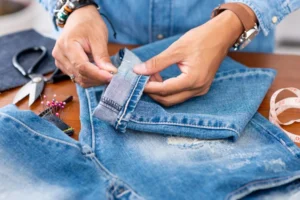The textile and clothing industry, often dominated by fast fashion, holds a significant position as the second-largest industry worldwide, accounting for nearly 10 percent of global energy consumption. However, the conventional clothing industry follows a standardized design and production process that can be resource-intensive and environmentally detrimental. This has led to a pressing need for a paradigm shift towards a more sustainable and efficient model. By understanding and reevaluating the stages involved, such as briefing, research, design, promotion, production, distribution, and retail, we can explore innovative approaches to minimize waste, reduce energy consumption, and prioritize ethical practices. This introduction sets the stage for a discussion on reshaping the standard clothing industry to foster a more environmentally conscious and socially responsible future.
Redesigning the Standard Clothing Industry
The textile and clothing industry, including fast fashion, is the second-largest industry in the world and consumes nearly 10 percent of the energy produced worldwide for its different processes from spinning to the finishing of final garments. This standard clothing industry has a clear standard design and production process model:
- Briefing Session: includes identifying problems and defining goals
- The Research: includes two steps: market research (color and style forecasting, trends, previous sales figures, etc.) and creative research (inspiration, cultural and historical sources, etc.)
- The Design Process: is influenced by research and includes sketches and drawings, proportion, line, balance, color and fabric choices, creating patterns and samples, range planning, etc.
- Promotion: Consists of orders taken and the range offered to buyers
- Production: includes sourcing and purchasing fabric, mass manufacturing, etc.
- Distribution: includes packaging and shipping
- Retail: shops, stores, etc.
Consumer: that is an interpretation of sales figures
The Environmental Impact of the Fashion Industry
Although the clothing industry, especially the fast fashion industry, has its own merits, meaning that it is a huge source of employment, tries to add value to clothing products, and caters to consumers’ needs as soon as possible via mass production, the effect of hazardous chemicals used and the amount of greenhouse gas emitted in the garment manufacturing process is undeniable. Discarded garments will go to landfills or get incinerated eventually and pose a serious threat to the environment. Fortunately, there is a growing awareness of the fashion industry’s inevitably negative impact on the environment that has raised concerns.
The Upcycling Revolution
One of the initiatives taken to reduce the harmful effect of toxic chemicals is the adaptation of a sustainable fashion model such as upcycling. This closed-loop fashion model is based on three principles: reduced production, reuse, and recycling of textile. This reverse logistics model can indirectly help provide employment by increasing job opportunities. The three processes included in this value chain are comprised of:
- Collection: defined as retrieving discarded products from the consumer
- Sorting: the inspection and categorization of the products according to quality and type
- Processing: in which different activities such as repair, washing, redesigning, etc. are included

Upcycled fashion design and production process model are:
- Fabric Sourcing: includes increasing textile banks, collecting post-consumer waste via a local textile collector, collecting post-industrial waste from local garment manufacturers, collecting waste garments via third parties such as charity organizations and non-government agencies, etc.
- Research: the collection of information about the availability of fabrics according to their color, pattern, or size, consumer feedback and preferences, and initial ideas related to trends and styles.
- Design: that is influenced by research and consumer preferences including color palette, sketches and design development, proportion, textile manipulation, draping, patchwork pattern cutting, designs, and range planning.
- Promotion: including wholesale orders taken, communication with consumers, and social media or online promotion.
- Production: includes pattern grading, local independent homeworkers, and seamstresses assigned to manufacture specific parts within a limited time, etc.
- Retail: shops, stores, or online
- Consumers: includes sales figures, feedback, and preferences, consumer and community engagement such as clothes swaps, fashion shows, or product trials, social media, and online promotion.
Last Word
As a result, upcycling has generated a great deal of interest in consumers for old clothing products. Whereas fashion trends are fast-changing as a result of particular designs or styles becoming outdated after a certain amount of time, upcycling reduces dependence on natural resources and increases the aesthetic value that can lead to enhancement reuse of items. Upcycling gives new life to the products that are on the verge of discard.




